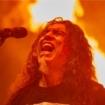At one fateful point during the time when Atlanta's Mastodon were gathering ideas for what would become their 2004 breakthrough album, Leviathan, drummer Brann Dailor found himself on a hellish 30-hour plane trip with nothing to pass the time except a copy of Moby-Dick. He already had a water motif in mind for the disc—Mastodon's previous record, Remission, was fire-themed—but before he read Herman Melville's 1851 maritime classic about Captain Ahab's hunt for the "salt-sea mastodon," Dailor admits that his ideas for what eventually became Leviathan were "pretty fucking vague."
Enter Paul Romano, who had done the artwork for Remission and Mastodon's 2001 EP, Lifesblood, and has since completed covers for Trivium, the Red Chord, and Hate Eternal, to mention just a few. "Brann called me from an airport somewhere and said, 'I just read Moby-Dick. You should read it. I think I'm gonna base the next record on it.'"

Not only did the Philadelphia-based artist read the novel, long a staple of high school English classes, but he also did extensive research. "I read critical essays on the book and on Melville," he explains. "I even went to the Philadelphia Public Library and saw the original book that Melville was inspired by—Narrative of the Most Extraordinary and Distressing Shipwreck of the Whale-Ship Essex, by Owen Chase. There's also a book by [legendary comparative mythologist] Joseph Campbell called The Mythic Image, and I'm all over it whenever I do Mastodon stuff—it links the symbolism of all the world's cultures."
Romano combined his inspirations in a 52-by-52-inch oil painting that deifies Melville's white whale, Hindu-style. "That crown of cobras on the whale's head is called Ananta," he says. "When you see images of Vishnu [the Supreme Being in Hinduism], you'll see the crown of cobras behind him that represents the endless and the eternal. Vishnu is essentially the creator: He dreams us, and we dream him. Going back to ideas in Moby-Dick and the book's references to God, I made the whale a god."
Many of the painting's more elaborate elements, like the Japanese Hokusai wave, harpoon-wielding Indonesian puppets, and the mystical Pharos (or Lighthouse) of Alexandria—one of the original Seven Wonders of the World—aren't visible on the CD cover but appear in the booklet and in the gatefold LP version of Leviathan—not to mention on the slew of import and limited CD iterations that have appeared since the album's initial release.
"I used to be a big-time record collector, and finding all the different versions of a certain album used to drive me nuts," Romano laughs. "Now I'm contributing to the problem."










